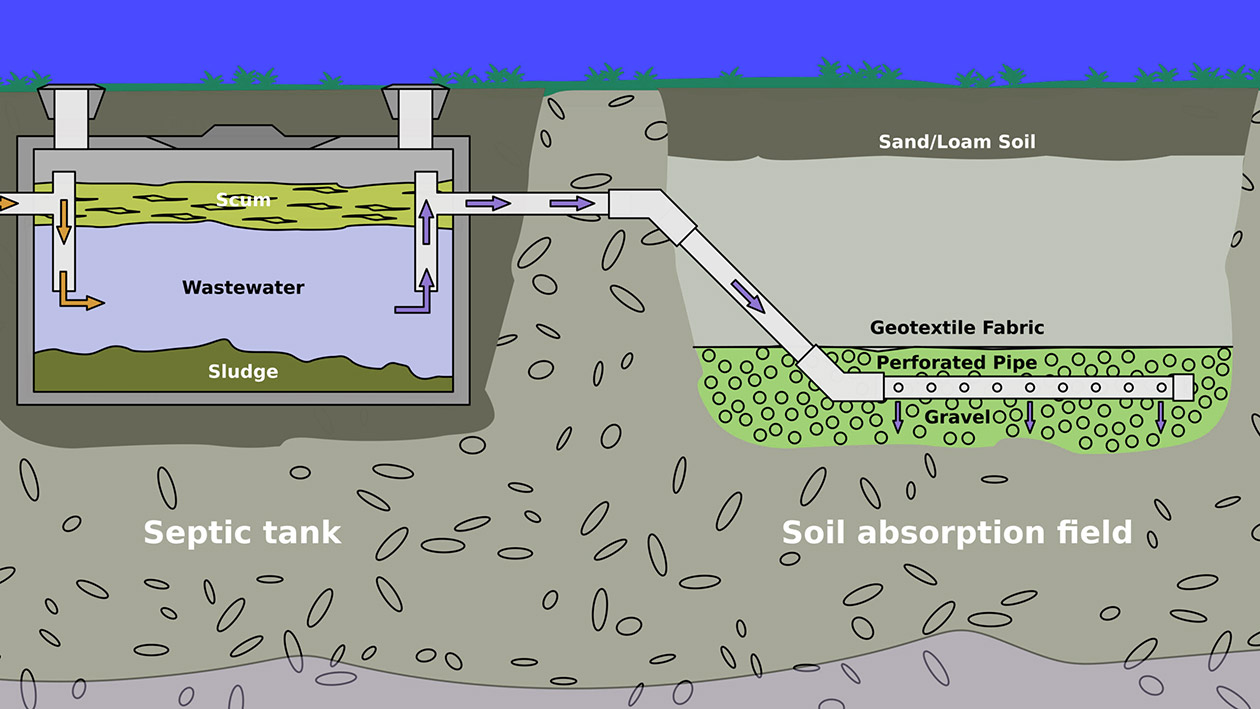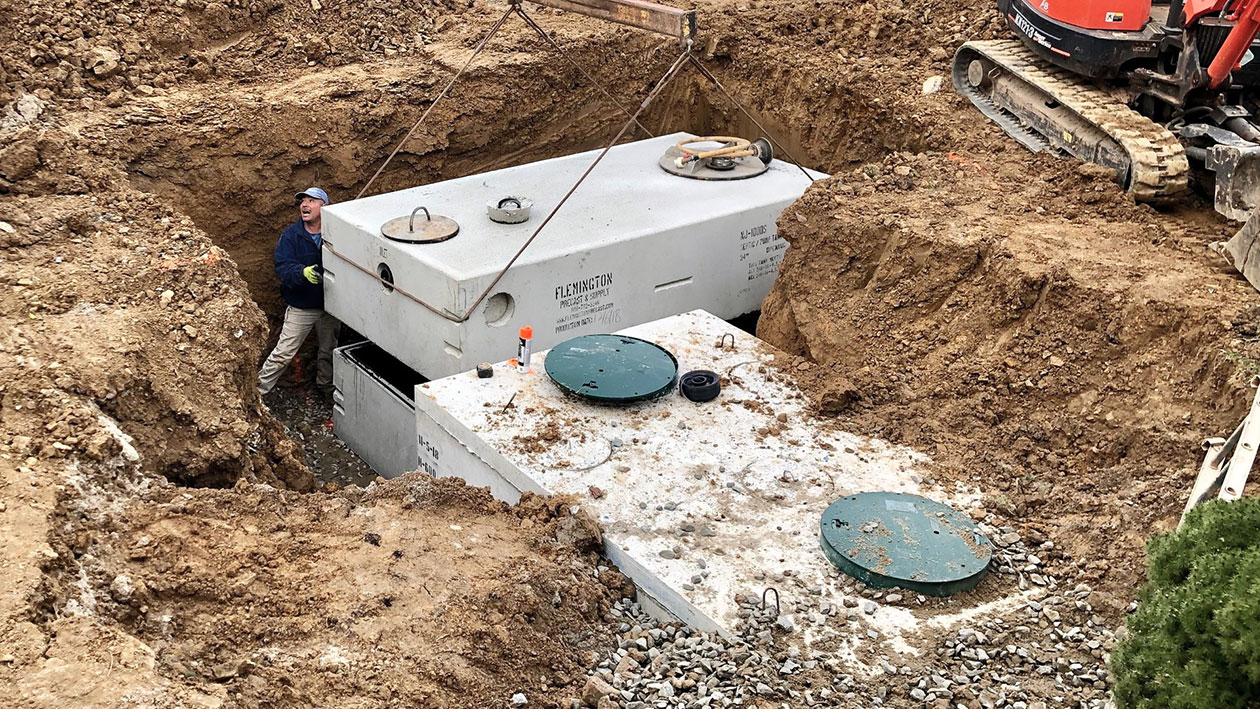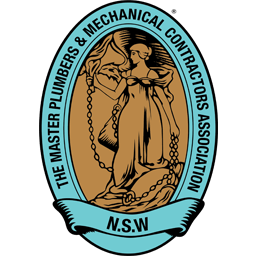Are you unfamiliar with septic systems? Millions of homes use them to treat wastewater. Understanding how they work is crucial for their proper maintenance. This guide explains everything you need to know.
How a Septic System Works
Imagine this. You flush the toilet. Water and waste travel from your pipes into the septic system buried in your yard. This system acts like a mini, on-site sewage treatment plant. Here’s how it happens:
- Entry: Wastewater exits your house through a main drainage pipe, flowing into the septic tank.
- Separation: The septic tank, a large buried container, separates the waste into three main layers. Each layer has a purpose. Heavy solids settle at the bottom, forming sludge. Lighter materials like grease and oils float to the top, creating scum. Partially clarified wastewater remains in the middle.
- Breakdown: Naturally occurring bacteria in the tank break down the solid waste. This process reduces its volume.
- Discharge: The partially treated wastewater exits the tank and enters the drain field, which usually consists of trenches filled with gravel or other drainage material.
- Final Treatment: In the drain field, the wastewater slowly filters through the soil. Soil microbes further treat the water, removing harmful bacteria and pollutants.
- Percolation: Finally, the treated water percolates into the surrounding soil and groundwater. This completes the natural wastewater treatment cycle.

Components of a Septic System
Two main components make this natural treatment process possible:
1. The Septic Tank: Your Underground Treatment Plant
Think of the septic tank as the stomach of your septic system. This buried, watertight container performs a few vital functions:
- Waste Separation: The tank’s design slows down wastewater flow, allowing solids to settle and scum to rise.
- Sludge Storage: The settled solids at the bottom form sludge. This sludge needs periodic pumping to prevent tank overflow.
- Bacterial Digestion: Bacteria living in the tank digest the solid waste, reducing its volume over time.
2. The Drain Field: Nature’s Filter
Once the wastewater leaves the tank, it enters the drain field. This underground network of trenches and pipes facilitates further treatment:
- Distribution: The drain field distributes the wastewater evenly over a large area.
- Filtration: The gravel or soil in the trenches acts as a filter, removing remaining contaminants.
- Final Treatment: Microorganisms in the soil break down any remaining organic matter.
Dylan Attard, a licensed plumber at True Flow Plumbing and Drains, has the following tip: “Did you know your septic tank might have a built-in filter? This filter, usually located near the outlet baffle, acts like a sieve, preventing solids from escaping the tank and clogging the drain field. It’s essential to have this filter inspected and cleaned regularly, alongside your scheduled tank pumping, to ensure optimal system performance.”
Types of Septic Systems
While the basic principle remains the same, septic systems come in various types. Here are the most common:
- Conventional System: The most common type, relying on gravity to move wastewater from the tank to the drain field.
- Chamber System: Uses chambers instead of trenches in the drain field, often requiring less space.
- Aerobic Treatment System: These systems use oxygen to encourage faster and more efficient wastewater breakdown. They are more complex and require electricity but offer a higher level of treatment.
Essential Septic System Maintenance
A well-maintained septic system can last for decades. Neglect, however, can lead to costly repairs and environmental hazards. Here are key maintenance tips:
- Regular Pumping: The most crucial task is regular septic tank pumping. Pumping removes accumulated sludge and scum, preventing solids from overflowing into the drain field. The frequency depends on household size and water usage but generally occurs every 3-5 years.
- Water Conservation: Reducing water usage lessens the burden on your septic system, extending its lifespan. Simple changes like fixing leaks, using low-flow fixtures, and spreading laundry loads make a difference.
- Drain Field Care: Protect your drain field by avoiding driving or parking heavy vehicles. Don’t plant trees or large shrubs near the area, as their roots can damage the system.
- Watch What You Flush: Never flush anything other than human waste and toilet paper down the toilet. Items like feminine hygiene products, wet wipes, paper towels, and cooking grease can clog pipes and damage the system.
By following these tips, you can ensure your septic system operates efficiently for years.
Septic System Trouble? Spotting and Preventing Problems
Like any complex system, septic systems can experience problems. Understanding the warning signs and taking preventive measures can save you headaches and expensive repairs. Here are common septic system issues:
- Slow Drains and Odours: If you notice multiple drains in your house are draining slowly or detect foul odours near drains or the septic tank, it could indicate a system backup or clog.
- Gurgling Sounds: Gurgling sounds in the plumbing, especially after flushing a toilet or using a drain, could signify a blockage in the system.
- Pooling Water: Standing water or unusually lush vegetation near your septic tank or drain field often signals a system failure or overload.
- Sewage Backup: This is a serious problem indicating system failure. If you experience sewage backing up into your home, contact a professional immediately.
Preventing these problems is often easier than dealing with the consequences. Remember to:
- Schedule regular inspections: Professional septic system inspections every few years can identify minor issues before they escalate.
- Use water wisely: Excessive water usage overloads the system. Be mindful of your water consumption.
- Be cautious about what goes down the drain: Only human waste and toilet paper belong in the toilet. Avoid flushing anything that could clog the system.
Being proactive and informed lets you keep your septic system working efficiently and avoid unpleasant surprises.
Frequently Asked Questions
Does shower water go into a septic tank?
Yes, shower water does go into a septic tank. In a typical household plumbing system, all the wastewater, including that from showers, sinks, toilets, and washing machines, flows into the septic tank. This water is known as grey water when it comes from sources like showers and sinks, as opposed to black water, which comes from toilets and contains human waste. Once in the septic tank, the wastewater is treated through natural processes, where solids settle at the bottom as sludge, and the liquid effluent eventually flows out to a drain field for further treatment and dispersal into the soil.
How often should you empty your septic tank in Australia?
In Australia, it is generally recommended to pump out a septic tank every 2 to 5 years. However, the exact frequency can vary based on several factors:
- Household Size: Larger households generate more wastewater, which can fill the septic tank more quickly. Therefore, homes with more occupants may need more frequent pumping.
- Tank Size: The capacity of the septic tank also influences how often it needs to be emptied. Smaller tanks will fill up faster and require more frequent maintenance.
- Usage Patterns: The amount of water and waste entering the system can affect the pumping frequency. For example, if a household uses a lot of water or disposes of non-biodegradable items down the drain, the tank may need to be pumped more often.
- Maintenance Routine: Regular inspections and maintenance can extend the time between pump-outs. Proper care ensures that the septic system functions efficiently, reducing the need for frequent pumping.
It’s important to monitor the condition of your septic system and consult with a professional to determine the best pumping schedule for your specific situation. Regular maintenance and timely pumping prevent system failures and costly repairs.



